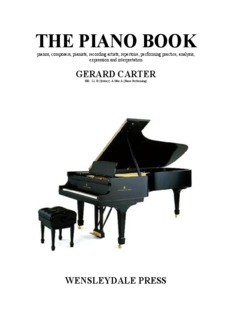‘The Piano’ PDF Quick download link is given at the bottom of this article. You can see the PDF demo, size of the PDF, page numbers, and direct download Free PDF of ‘The Piano’ using the download button.
The Piano Story PDF Free Download

Introduction
‘Piano’ is a musical instrument that is played through the keyboard. person playing The piano is called the ‘pianist’.
‘Piano’ is a shortened form of ‘pianoforte’ which is rarely used except in formal use.
Language. ‘Pianoforte’ is derived from the original Italian name ‘clavicemblo col piano e’.
forte’ or ‘harpsichord with soft and loud’.
It refers to the reactivity of the equipment keyboard fingering, which allows the pianist to produce notes at different dynamic levels By controlling the speed at which the hammers strike the strings The piano produces its sound from tuned strings that are struck with felt hammers.
When a key is pressed it activates a mechanism that throws the hammer.
The fretting removes the string and the damper to allow the string to vibrate freely.
The hammer strikes the string, bounces off and is caught by the test apparatus. a string The vibration occurs at a set pitch, or frequency, which is different for each note.
The strings are pulled tightly over the bridges which are mounted on the soundboard.
through which the vibration is transferred. The sound is amplified through the soundboard Which is a large flat piece of wood that effectively acts as a large loudspeaker.
When the key is released the hammer falls back to its normal resting place The damper is pressed back onto the string to stop the vibration and sound.
Piano is basically a horizontal harp but is played with hammers Instead of breaking keys with fingers.
The piano is widely used in Western music for solo or vocal performances.
Other instruments or orchestra. It is also used in composition and rehearsal.
although not Portable and often expensive, the piano’s versatility and ubiquity has made it one of the most popular The most familiar of all musical instruments.
The piano keyboard provides an easy means of melodic and harmonic interplay and piano They were and are often used by musicians in home music production as well.
They were and still are extremely popular devices for personal ownership and use concert Hall.
An ordinary piano is called an ‘acoustic’ piano, as opposed to an electronic piano.and digital piano.
tone
Accents on individual notes and chords were marked with FP and SFP by musicians.
during the early classical period. only later came the inverted V for strong pronunciation and the lateral V came into more common use for lighter accents.
It is often hard to tell From his markings in Chopin’s autograph manuscripts whether the sideways V is intended an accent or diminutive.
Schumann’s use of accent marks was curious even today Sometimes he used them on each note of a melodic line.
In playing the piano, the pianist usually puts an accent in 3/4 on the first beat of each bar.
or 4/4 bar. The mazurka has a secondary accent on each second or third beat.
bar, or every other bar, depending on the particular mazurka. alla breve are there in time Not four but two beats are considered in a bar.
Dwelling on a vowel or chord for a short time is called egoic pronunciation.
but that’s what it means At least some mild accent marks in Chopin.
Rachmaninoff used the minor sostenuto line to indicate egoic pronunciation
In 1905 d’Albert gave the United States première of his own second piano concerto with the Boston Symphony Orchestra.
He succeeded Joachim as Director of the Berlin Hochschule in 1907, and performed Liszt’s E major Polonaise at the Liszt Festival which was held at the Liszt Academy of Music, in Budapest, from 21 to 25 October 1911.
He wrote piano music and twenty-one operas, one of which, ‘Tiefland’ is still occasionally performed.
He performed Beethoven, Brahms and Liszt and was one of the first to perform Debussy in Germany. Reger started to write a piano concerto for d’Albert but never finished it.
D’Albert’s pupils included Ernst von Dohnányi, Wilhelm Backhaus and Edouard Risler.
Among his marriages was one of three years, 1892-1895, to the pianist, Teresa Carreño.
They had daughters Eugènie and Hertha. He spent much of his life in Germany and became a German citizen. He lost much of his British following when he took up the German cause in the First World War.
‘The Collected Works of Franz Liszt’ were published by Breitkopf & Härtel in 34 volumes between 1907 and 1936.
They were edited under the aegis of the Franz Liszt Foundation by Eugen d’Albert, Ferruccio Busoni, Peter Raabe, August Stradal, José Vianna da Motta, Bernhard Kellermann, Béla Bartók, Otto Taubmann, Philipp Wolfrum and Bernhard Stavenhagen.
D’Albert made two Liszt discs, and several Liszt rolls. D’Albert issued a highly ‘edited’ edition of the Sonata, and an edition of the E flat major piano concerto providing Liszt’s comments ascertained in discussions with him at Weimar in 1875.
He also issued an edition of the Hungarian Rhapsodies. In later years d’Albert concentrated on composition rather than on his career as a concert pianist.
| Writer | Sandra Rodriguez |
| Language | English |
| Pages | 446 |
| Pdf Size | 5.4 MB |
| Category | Music |
The Piano Book Pdf Free Download

Excellent book